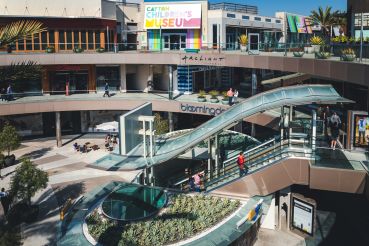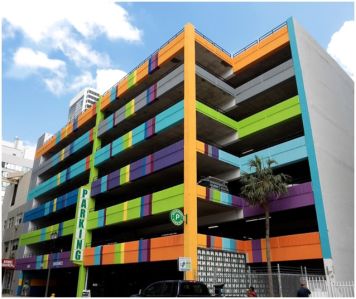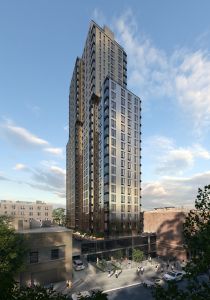Hooray for Hourihan: CBRE’s CIO Is Leading Its Platform Through Uncharted Territory
By Cathy Cunningham October 20, 2020 11:37 am
reprints
Kim Hourihan could have been a tech millionaire.
The year was 1995, and Hourihan, a Harvard Business School student, had teamed up with two friends from the Massachusetts Institute of Technology (MIT) who had engineered a set-top box that could be attached to televisions for internet connection. Hourihan’s role? Pitching venture capital firms that the information superhighway was for the common man.
“I had written a business plan, saying that the internet is the way to go, and you can get it through your TV,” Hourihan said. It was a genius idea, even if the timing and circumstance was slightly off.
“It didn’t work out,” said Hourihan. “But, one of the co-founders of Microsoft, Paul Allen, founded a company called WebTV and sold it for $425 million.”
She added: “Not that I’m bitter.”
Nevertheless, it turned out extremely well for the commercial real estate industry. Hourihan had been doing construction loans prior to the tech detour and returned. In 2007, she landed at CBRE (CBRE). Shortly thereafter, she launched one of the firm’s flagship real estate funds. Flash forward to 2020, when she was promoted to chief investment officer for the Americas.
Leading investment strategy for CBRE’s Americas platform during a global pandemic is no mean feat, but Hourihan also maintains her previous position as a portfolio manager for CBRE Global Investors, which has a whopping $110 billion in assets under management today. In her role, Hourihan is responsible for portfolio-level oversight of acquisitions, dispositions, asset management, investor relations and capital raising. Over the years she’s cultivated a diverse workforce, and diveristy and inclusion initiatives continue to be one of her top priorities today.
In 2012, CBRE’s research team made a sector call that industrial/logistics would outperform, and this shaped its investment recommendations across the Americas platform, which turned out to be a pretty great bet when COVID-19 hit.
And the pandemic hasn’t slowed the flow. In addition to its recent acquisition of 605 Tri State, a 255,272-square-foot industrial asset in Chicago, CBRE Global Investors acquired a creative office building, the Millwright Building, in Minneapolis, Minn. in September, plus two Class A office buildings in San Jose, Calif., in July. The latter acquisitions are part of a broader strategy to acquire properties in key office markets across the U.S., and both investments cater to a post-COVID-19 world, with large floorplates that accommodate de-densification efforts.
Hourihan has been staying at her Southport, Conn., house during the pandemic, but is eager to get back to her West Village home. “New York has proven people wrong time and time again, so I never bet against New York,” she said.
Commercial Observer caught up with Hourihan via another technological advance that made a pretty penny — Zoom — to hear what she’s seeing in a rapidly changing market.
Commercial Observer: How did you get your real estate start?
Kim Hourihan: I grew up in Massachusetts, and my interest began in my early high school years. My uncle was a schoolteacher, and you don’t really make lots of money as a teacher. So, he would buy two-family apartment buildings, then three-family buildings, and then eventually 10- or 12-unit buildings.
In the summer and over school holidays, I would help him to remodel apartments. We’d go in, and put in a new toilet, or take down wallpaper, or paint the place — whatever it took — and I think that sort of gave me the bug. It was fun to do, and there was always instant gratification. You could drive by and say, “Oh, that’s the apartment building.”
How did your early appreciation for real estate evolve, in terms of, knowing what you wanted to do as a career?
I majored in economics [at Boston College], but I really didn’t have any grand plan. When I made the decision to go to [Harvard Business School], I found out that the applications were due in four weeks, and I had a ski holiday coming up. So, in the morning, I’d write an essay and, in the afternoon, go and ski.
Real estate was really tough to get into then. There wasn’t an order, the way there is in banking, where you have a training program, and everyone starts together on July 1. It was more, “Was your dad in real estate?” or whether you knew someone who knew someone.
When I graduated university, I ended up working in a bank doing construction loans [at U.S. Trust], but I knew I didn’t want to do that for the rest of my life. So, I did a non-real-estate thing for a while — which could have been a career killer but, fortunately, it wasn’t — and I ended up working for a Malaysian company [George Town Holdings BHD]. This was the 90s and the [Resolution Trust Corporation] days. I had sold a parking garage to a guy from Malaysia, who ran a company there, and ended up giving him the loan for it as well. He called me when I was graduating business school and said, “What are you doing now?” So, I moved to London and bought and sold companies for this Malaysian company. Then the Southeast Asia crash happened, and I didn’t want to move from London to Kuala Lumpur so I moved back to the U.S. and ended up getting into the investment management side of the business. The rest — as they say — is history.
You started at TA Associates Realty in Boston as a portfolio manager, but then joined Starwood Capital Group. What was your role there?
Starwood brought me on in 2006 to start a value-add fund. I wrote a business plan and was ready to go, but they didn’t pull the trigger. After about a year, I said, “Look, I still think this could be a good idea, but I’m going to look for another job and, if you decide in the meantime to pull the trigger, let me know.”
I had two offers: one was with a subset of a hedge fund that was doing opportunistic investing, mainly in South America; and I also had a job offer from CBRE to run their account with a sovereign wealth fund. I was talking to a friend from the New York Fed — keep in mind, this is the fall of 2007 — and he said to me, “We think we’re headed for rocky, rocky waters.”
I thought to myself, real estate is all about deep pockets, being able to keep your legs under you, and eventually things will come back. So, an opportunistic hedge fund approach in South America sounded a heck of a lot riskier than the largest sovereign wealth fund in the world. [In 2013], I, with CBRE’s help, of course, launched one of our flagship funds.
What’s great about CBRE is there’s sort of an entrepreneurial spirit within a big company, and one of the things that makes us unique is that we are the investor and the operator of all the properties. We’re not doing a bunch of [joint ventures] that are allocating money to real estate. We’re doing everything, soup to nuts; and, for a large firm like us, that’s a really unique characteristic.
Have your investment strategies evolved over the years?
Our strategies for our clients across the Americas have certainly evolved over the past several years. In 2012, our research team made a sector call that industrial/logistics would outperform, and this shaped our investment recommendations across the Americas platform, particularly for our core strategies. This turned out to be a great thing [in the wake of COVID-19].
Similarly, around 2016 or 2017, we were thinking about the fact that there’s usually a correction historically every seven years in the U.S., and we were sitting there at year eight thinking, “We have to be late in the cycle.” So, as part of our firm’s cycle-aware investment strategy, we pivoted to thinking about late-cycle outperformance and started to really de-risk our portfolios.
As we began 2020, with the economy looking great and everything coming up roses, it was easy to question the need to de-risk and de-leverage. But, because of our anticipation of a correction, as this crisis hit — Lord knows, no one predicted it — we were in as good a position as we could be.
What were the early days of COVID-19 like for you at CBRE?
Almost immediately, retail tenants were calling saying, “I’m shut down. I need help.” And so, our asset managers were basically working on retail over and over and over again. We also had some troubles around residential [assets], but the relief started coming in pretty quickly and people were getting checks, so residential backed off a little bit.
What were the most common investor questions back then?
People were most focused on rent collections. “How much did you collect with your retail tenants? How much did you collect in industrial?” And then, people would start to read the press and ask, “Alright, what about the future of office? No one’s in an office building right now, so is anyone going to want to go to an office again?”
I was here during 9/11, and I remember quite clearly everyone saying, “No one’s going to go in a high-rise ever again. No one’s going to want to be above the 10th floor.” All of these declarative statements. And now, everyone wants to be on the top floor again.
I do subscribe to the fact that the trends that you saw pre-pandemic were sped up by COVID-19. The retailers that were on their last leg anyway are now gone. And, all those retailers that were strong, are now even stronger. So, a lot of those trends can continue. You were already seeing people move out of San Francisco and New York because they’re expensive, so this trend isn’t new news.
There’s been a lot of press about the exodus from New York, post-COVID-19.
All of the reasons you live in New York City, you can’t access right now. You can’t go to a museum or the opera, and you can’t sit in a restaurant comfortably — half of them have closed, anyway. I live in the West Village, and there are places that have been open for 150 years and are now closing. It’s heartbreaking.
As an investor, I think you have to just cut through all the noise right now and ask, “In three years, what do I want to own and why?” I don’t think big cities are dead. I think all the reasons that people wanted to be in walkable places and near mass transit are still going to be in place. I’m lucky enough to have a house in Connecticut. That’s where I am right now, and I would spend my weekends up here, but I cannot wait to get the hell out of here. I love it up here, but I miss New York so much.
You speak with a lot of investors. What’s their current appetite for new investments?
It’s tough on investors, because a lot of them physically have to see properties. I have the same issue at some level, but I’m lucky because CBRE has somebody in most cities who can take a look at things. I actually did my first purchase of an office building in San Francisco by doing a FaceTime tour recently.
At a fund level, we’re making all the decisions, but if you’ve got a separate account, say a big sovereign wealth client or a big pension fund plan, they’re having trouble because of [COVID-19] issues.
We’re able to get to the properties, and there are some clients that we’ve worked with for a lot of years who will say, “If you guys can get some people there, we’ll go with you on this,” but that’s more the exception than the rule.

What will become of foreign investment in the near term?
Foreign investors are trying to figure out a way to make it work, instead of just saying “Forget it, I’ll come back in a couple of years.” As a firm, we do infrastructure, we do debt, we do securities, and we do direct real estate.
We’ve seen such an interest in real assets, and in my career, real estate has gone from a little bit of a quirky “some people do it, some people don’t,” to an absolute staple of any portfolio and a real institutional asset class. And we’ve seen the capital come along with that. I don’t see that abating anytime soon.
Is there primarily interest in gateway cities again from an investment perspective?
What everyone is interested in right now is industrial. And industrial gateway markets are not the same as office gateway markets. And I never think in terms of what’s a global gateway market in office.
It’s more a case of: Who’s the tenant? How long is the tenant there? Where is this office building, in terms of the competition? Because, you’ve seen a real change in what people want in office right now. That commodity office, in any market, whether it’s New York City or Nashville — it doesn’t matter. No one wants it. But, if you have that creative office with a cool vibe in any city, you’re going to attract Amazon and Google. And I would like to have a higher cap rate with Google in Philadelphia, than a low cap rate with Google in New York City.
I was never really a big, “Oh, just because I’m buying in New York City, this is a guaranteed investment and it’s going to be great.” I never really subscribed to that, as much as I love New York. New York City is certainly always on my list to look, but honestly, the last seven or eight years, it’s been so expensive. I would much rather have that 10-year Google lease in Nashville than I would in New York.
Any big surprises to come out of this downturn?
The surprise for me was how quickly pricing bounced back for industrial and apartments. I would say there was, maybe, a 45-day window where people were saying, “Okay, there’s a discount here.” But, since then, I would say industrial and multifamily are both at pre-pandemic pricing, if not, even more aggressive because of all the capital that’s out there.
This health crisis caused an economic recession, but is this just an extension of a blip in the old cycle — or is this actually a new cycle? Because, normally cycles have some sort of a bubble. There’s some irrational exuberance or something. None of that happened here.
This period during the pandemic has been an important time of reflection for our industry. How can we make commercial real estate a more inclusive industry?
There have been centuries and millennia of this in place. Breaking out of this is not going to happen in 2020, and it’s not going to happen in 2021. It’s a very, long run ahead.
I’m on the executive committee, and myself and a colleague are co-sponsors of our diversity and inclusion initiative. I’ve always been very active within the firm on D&I issues. And we had a town hall, actually, last week to talk about our three-year plan.
We’re all going to have D&I [key performance indicators], but we need everybody up and down pulling together on this, and it’s a long road. But you’ve got to just keep at it, and keep doing what you need to do.
One of the things that I really emphasized in the town hall was, this isn’t meant to take some privilege [away] from someone and give someone else that privilege. This is about leveling the playing field, so that we all have a fair competition.
It’s not just about recruiting people in, but rather, how do you keep people? How do you make it a more comfortable environment where people can actually get good, solid feedback that’s helpful and constructive? All of those things that are needed. It’s a huge issue in our industry, and in many industries.
Have you seen an improvement since you first came into the industry?
I’d say it’s better, but it still has a ways to go. I’m hopeful, but we have to keep at it. And we need white, male advocates to call each other out on some of the crap that goes on.
I actually told this story at the town hall meeting: I was at a global leadership team meeting in 2015, and we were asked to give two minutes on our goals for 2016. There’s a big horseshoe table, with [about] 40 people around the table. I was the second-to-last person to go, and I listened to everyone talk, saying “I want to increase EBITDA by X percent. I want to increase my AUM by X percent.” They were all very business focused. I was sitting there thinking, “Am I going to say this out loud?” But I stood up, I took a deep breath, and I said, “I want to put a spotlight on gender and diversity in this firm. We are wasting resources, and we can be better than this. I want to make us better.”
I have been a silent witness, but I will be silent no longer. When I talk to people about this, I say, “Look, it takes some courage, but you will feel better afterwards. Just speak up.” Because, I think people have muscle memory that says, “Oh, of course this is happening and it’s normal.” But, it’s not normal.


